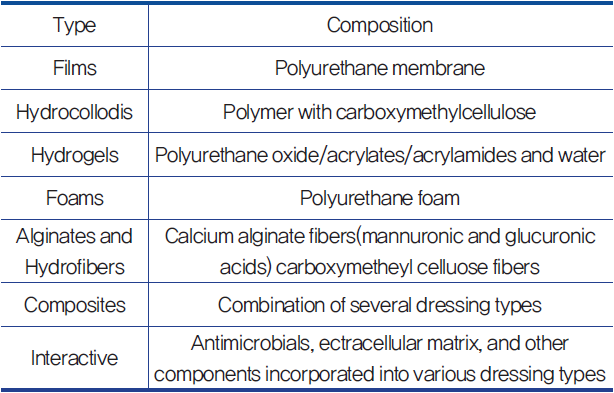

Table 2. Synthetic dressings.
These new synthetic polymer dressing materials with clear superiority have gradually replaced gauze type dressing which was in use for centuries.

Table 3. Benefits of synthetic polymer dressing materials.
However, the newer dressing materials were not effective enough in extensive skin damage or persistent chronic wounds. Biologically active dressing (biologic dressing) was introduced as a better option of wound dressing. Biologic dressing began its history in the 17th century B.C. when ancient Greeks and Romans used honey to dress wounds.
More recently, human amnion was used as the first biologic dressing in 19103. As technology developed, various other materials including growth factor extraction, keratinocyte culture, amnion and collagen, etc. were used as a biologic dressing.
Biologic Dressing Using Cultured Keratinocytes
Since Reverdin discovered the benefit of epithelial island in burn wounds in 1869, the gold standard of wound healing was autologous skin graft. However, donor sites are hard to come by in patients with massive burns and additional complications and scarring in the donor site wounds was another problem. In 1975, Rheinwald and Green4 successfully cultured drastically greater amounts of keratinocytes from human original skin sample. Cultured keratinocytes were first used in 1980 in an adult patient with burn wounds5.
[Advertisement] A-One LITE(Facial Diagnosys System) – Manufacturer: BOMTECH(www.bomtech.net)
In 1984, Hefton and Amberson6 removed cells with HLA-DR markers during the culture process, which allowed use of cultured allogeneic keratinocytes. This removed the inconvenience of biopsy and the time spent on obtaining keratinocyte culture. Previously cultured keratinocytes can be immediately used in burn patients without rejection even in long-term follow-up.7-11 In Korea, TEGO Science developed Holoderm, an autologous cultured skin in 2000 and Keloderm, cultured allogeneic keratinocytes, in 2005. Holoderm and Keloderm are currently being used in burn wounds.
-To be continued




















